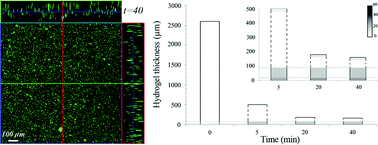Effect of chitosan incorporation on the consolidation process of highly hydrated collagen hydrogel scaffolds
Abstract
Collagenous body tissues exhibit diverse physicochemical and biomechanical properties depending upon their compositions (e.g. proteins, polysaccharides, minerals and water). These factors influence cell function and can contribute to tissue dysfunction and disease when they are either deficient or present in excess. Similarly, the constituents of tissue engineering hydrogel scaffolds must be carefully considered for the optimal design of engineered constructs for therapeutic applications. As a natural polysaccharide glycosaminoglycan-analog, chitosan (CTS) holds potential for generating highly hydrated collagen type I hydrogel (Coll) based scaffolds that mimic the native extracellular matrix. Analysis of fluid loss in Coll–CTS hydrogels undergoing either a gravity-driven consolidation process (self-compression; SC) or plastic-compression (PC) offers the potential for the controlled production of tissue-equivalent dense hydrogels with tailored physical and mechanical properties. Herein, the effect of CTS on Coll gels microstructural evolution involved in SC and PC was investigated by detecting the spatiotemporal distribution of fluorescent beads within Coll–CTS hydrogels using confocal microscopy. The hydraulic permeability (k), pre- and post-consolidation, as a function of CTS content, was estimated by the Happel model. The effect of CTS fixed charge on dense Coll–CTS hydrogels was investigated through structural, mechanical and swelling characterizations under isotonic and hypertonic conditions. Image analysis revealed a temporal increase in bead density, with both rate and extent of consolidation, correlating strongly with increasing CTS content. k decreased from 1.4 × 10−12 to 1.8 × 10−13 m2 and from 2.9 × 10−14 to 6.8 × 10−15 m2 for highly hydrated and dense hydrogels, respectively, with higher amount of CTS, resulting in a concomitant increase in the scaffold compressive modulus (from 7.65 to 14.89 kPa). In summary, understanding the effect of CTS on Coll hydrogel properties enables the development of tailored scaffolds for use as tissue models for various biomedical applications.


 Please wait while we load your content...
Please wait while we load your content...